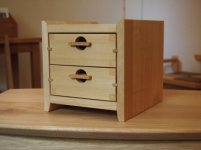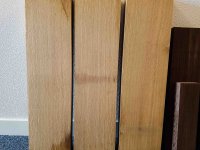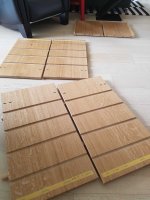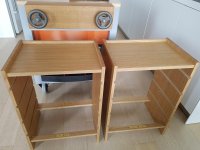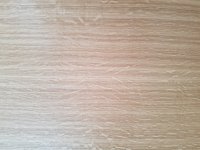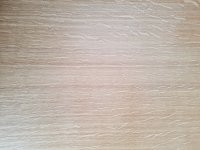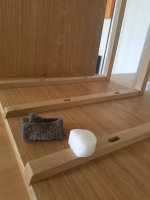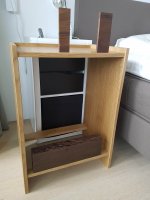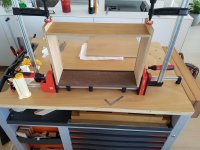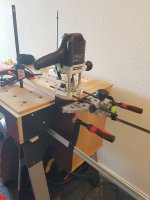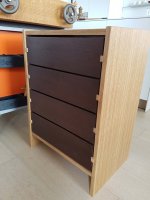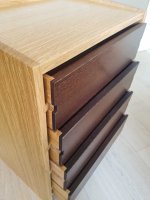CirclDigital
Member
- Joined
- Jul 23, 2018
- Messages
- 71
A few months ago I bought some pretty nice white oak and have been thinking about using it for a project.....
And after seeing this design I thought it, as a broad design idea, would also work for a set of nightstands that would replace the ones I currently use.
[attachimg=1]
The oak that I had bought would suffice for the 4 sides and tops and was just wide enough that it could be resawn and bookmatched. After the getting everything roughly square and to size I could see a bit more of the wood and grain pattern that I was starting with.
[attachimg=2]
The resawing didn't quite work out as I had anticipated (or hoped). The bandsaw blade wandered a bit in most boards so I ended up with a somewhat thinner board than I had calculated. But a careful glue-up and some moderate planing gave me just enough thickness to continue. I should have known that starting with a rough board that is 55mm thick it would be nearly impossible to get a panel that is 24mm. In the end I had a flattened panel that is 21mm, not as good but still aesthetically pleasing in my design.
[attachimg=3]
The construction was done with domino's since I didn't want to clutter the design with dovetails or through tenons. And a router was to be used to cut the dado's for the drawer runners. Spacing those dado's was pretty critical in getting a good result since the only way to get an even spacing between the drawers was getting the placement of the dado's in the carcass and the groove in the drawers lined up correctly. So I build a jig, from plywood, that could be fitted to the panel where all the dado's could be routed by using the 30mm guide bushing. This worked great and I ended up with panels that were identical.
I do like working with the Domino XL and OF1400 for such tasks.
[attachimg=4]
And after seeing this design I thought it, as a broad design idea, would also work for a set of nightstands that would replace the ones I currently use.
[attachimg=1]
The oak that I had bought would suffice for the 4 sides and tops and was just wide enough that it could be resawn and bookmatched. After the getting everything roughly square and to size I could see a bit more of the wood and grain pattern that I was starting with.
[attachimg=2]
The resawing didn't quite work out as I had anticipated (or hoped). The bandsaw blade wandered a bit in most boards so I ended up with a somewhat thinner board than I had calculated. But a careful glue-up and some moderate planing gave me just enough thickness to continue. I should have known that starting with a rough board that is 55mm thick it would be nearly impossible to get a panel that is 24mm. In the end I had a flattened panel that is 21mm, not as good but still aesthetically pleasing in my design.
[attachimg=3]
The construction was done with domino's since I didn't want to clutter the design with dovetails or through tenons. And a router was to be used to cut the dado's for the drawer runners. Spacing those dado's was pretty critical in getting a good result since the only way to get an even spacing between the drawers was getting the placement of the dado's in the carcass and the groove in the drawers lined up correctly. So I build a jig, from plywood, that could be fitted to the panel where all the dado's could be routed by using the 30mm guide bushing. This worked great and I ended up with panels that were identical.
I do like working with the Domino XL and OF1400 for such tasks.
[attachimg=4]

